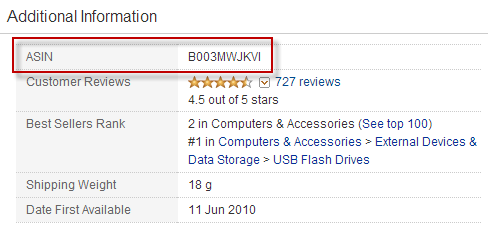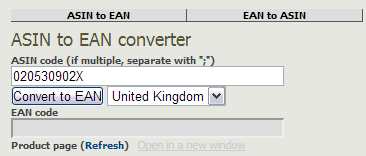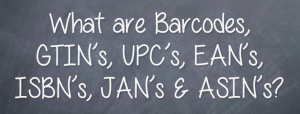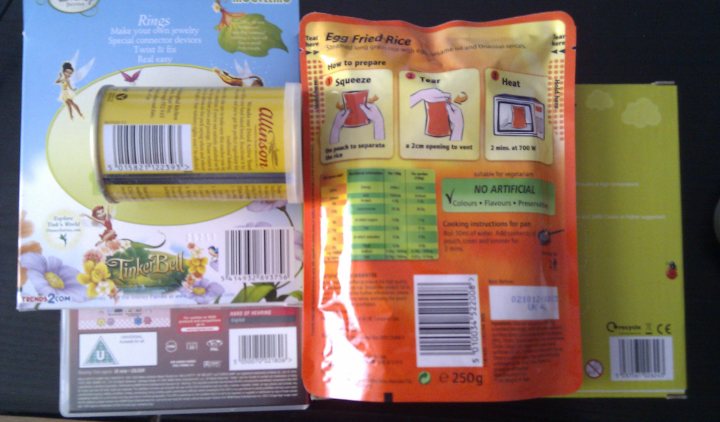Do I Need a Barcode to Sell on Amazon?
This was a question asked a few days ago at the Brightpearl Commerce Acceleration 101 I presented at a few days ago and I thought it’s worth sharing with you.
So do you need one?
Yes and no.
The answer really depends on if the product you are selling is already listed on Amazon or not and I’ll explain why.
If the product is already listed on Amazon
Then this is “happy days“, all we need is the key and key is something called an ASIN.
This is pronounced “A-SIN” and stands for “Amazon Standard Identification Number”. Once a product has been loaded onto Amazon, Amazon gives the product a unique key that is not the barcode and looks like this example “B003MWJKVI” which is for a memory stick.
If you pick any item on Amazon, you’ll notice that not only in the page URL you see the ASIN of the product like below:

An ASIN in the Amazon URL for a product
Also the ASIN can be found further down the product page and looks like the screen shot below:

An ASIN in the Amazon product page
It should be noted that the ASIN still refers to the barcode (or the correct name is GTIN or EAN) but unlike where a barcode is meant to be for a single product only, an ASIN can refer to more than one barcode. Barcodes are leased not bought and can be re-used, hence that’s why you can sometimes find a barcode belonging to more than one product on Amazon.
Oh, if you’d like know the differences between an ASIN, GTIN, EAN, UPC or JAN then take a look at this article, as I covered that last year and a video explanation is also included too.
If the product is not listed on Amazon
Now this is not “bad days”, it just means that we need to locate the barcode for the product.
Most mainstream products have barcodes assigned and are on the product itself, just look for the numbers below the stripy label. However, if you’ve got a product that is new or undocumented on Amazon, then you’re going to need a barcode to create it on Amazon with.
There are a collection of sites on the interwebs that you can buy a barcode for a few pounds, these are fab if you only have a few products, but I’m guessing you have lots and this where you need to speak to a company called GS1. You can find them here http://www.gs1uk.org/.
Barcodes are not bought, they are leased
This means that you can lease a range of barcodes and if you’re wondering “how many do you get?” basically you are given as many as you need. This could be 10,000 this could be several million depending on your requirements.
To subscribe to GS1, the rough prices are £250 for the first year and £125 for the next years subscription as the first year they charge you ~£125 set up fees. But you get as many barcodes as you need to use and if you run out, you can go back and ask for more.
A full breakdown of the pricing can be found here: http://www.gs1uk.org/about-us/Pages/Become-a-member.aspx
Oh and how to find out the barcode of an ASIN?
 That’s a little more tricky if you have lots of products and you need to use the Amazon Product Advertising API to look them up. But…. if you know the ASIN, then the tool at the link below will convert them for you, for free!
That’s a little more tricky if you have lots of products and you need to use the Amazon Product Advertising API to look them up. But…. if you know the ASIN, then the tool at the link below will convert them for you, for free!
http://erwinmayer.com/labs/asin2ean/index.php
If you want to know the ASIN’s of the variations of products listed on Amazon with variations, you may wish to contact me directly as I have a script that I use with clothing and footwear businesses to look the variation ASIN’s up on Amazon for existing products, all in a deliciously simple CSV file for its output.
Hope that helps!

 Barcodes, these can cause confusion, especially if we account for all the different names they can be referenced as and even the term barcode isn’t technically correct, GTIN is. As such this article aims to dis-spell the myths & confusion around them and give you the 101 on the different variations, what they are and how they’re used.
Barcodes, these can cause confusion, especially if we account for all the different names they can be referenced as and even the term barcode isn’t technically correct, GTIN is. As such this article aims to dis-spell the myths & confusion around them and give you the 101 on the different variations, what they are and how they’re used. The ‘barcode’ is the vertical lines and these are the visual form of the numbers below, ie 012345678900. However for ease, very few people know what GTINs are and the term “barcode” will make more sense to more people as we’ve all seen them on products, like soup. So I’m calling them ‘barcodes’.
The ‘barcode’ is the vertical lines and these are the visual form of the numbers below, ie 012345678900. However for ease, very few people know what GTINs are and the term “barcode” will make more sense to more people as we’ve all seen them on products, like soup. So I’m calling them ‘barcodes’. These you’ll find on books, this is because ISBN is short for ‘International Standard Book Number’ and can come in both 13 and 10 digit numbers.
These you’ll find on books, this is because ISBN is short for ‘International Standard Book Number’ and can come in both 13 and 10 digit numbers.
